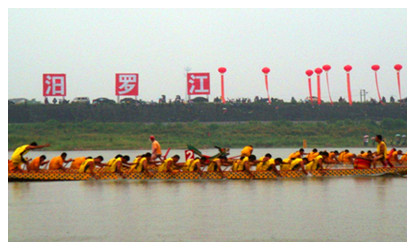
Miluo River and Qu Yuan
 Miluo River has a total length of 253 km, a basin area of 5,543 square kilometers. Miluo River originates in Xiushui County, Jiangxi Province, and the west flows through the Pingjiang Xian, Miluo City (Mi-water and LUO Jiang-in the county in the concourse), into the Xiangjiang River to Xiangyin County. The trunk stream is 253 km long, the basin area 5,543 sq. miles, the largest tributary in the Xiangjiang River range in north Hunan Province.
Miluo River has a total length of 253 km, a basin area of 5,543 square kilometers. Miluo River originates in Xiushui County, Jiangxi Province, and the west flows through the Pingjiang Xian, Miluo City (Mi-water and LUO Jiang-in the county in the concourse), into the Xiangjiang River to Xiangyin County. The trunk stream is 253 km long, the basin area 5,543 sq. miles, the largest tributary in the Xiangjiang River range in north Hunan Province.
Miluo River & Qu Yuan
Qu was a Chinese scholar and minister to the King from the southern Chu during the Warring States Period. His works are mostly found in an anthology of poetry known as Chu Ci. His death is traditionally commemorated on the occasion of the Duanwu Festival (端午节/端午節), which is commonly known in English as the Dragon Boat Festival or Double Fifth (fifth day of the fifth month of the traditional Chinese calendar).
 In 278 BC, learning of the capture of his country's capital, Ying, by General Bai Qi of the state of Qin, Qu Yuan is said to have written the lengthy poem of lamentation called "Lament for Ying" and later to have waded into the Miluo river in today's Hunan Province holding a great rock in order to commit ritual suicide as a form of protest against the corruption of the era.
In 278 BC, learning of the capture of his country's capital, Ying, by General Bai Qi of the state of Qin, Qu Yuan is said to have written the lengthy poem of lamentation called "Lament for Ying" and later to have waded into the Miluo river in today's Hunan Province holding a great rock in order to commit ritual suicide as a form of protest against the corruption of the era.
Qu Yuan is regarded as the first author of verse in China to have his name associated to his work, since prior to that time, poetic works were not attributed to any specific authors. He is considered to have initiated the so-called sao style of verse, which is named after his work Li Sao, in which he abandoned the classic four-character verses used in poems of Shi Jing  and adopted verses with varying lengths. This resulted in poems with more rhythm and latitude in expression. Qu Yuan is also regarded as one of the most prominent figures of Romanticism in Chinese classical literature, and his masterpieces influenced some of the greatest Romanticist poets in Tang Dynasty such as Li Bai.
and adopted verses with varying lengths. This resulted in poems with more rhythm and latitude in expression. Qu Yuan is also regarded as one of the most prominent figures of Romanticism in Chinese classical literature, and his masterpieces influenced some of the greatest Romanticist poets in Tang Dynasty such as Li Bai.
Other than his literary influence, Qu Yuan is also held as the earliest patriot in China's history. His social idealism and unbending patriotism have served as the model for Chinese intellectuals to this day, particularly following the establishment of new China in 1949. For example, in the 1950 s China issued a postage stamp bearing the "likeness" of Qu Yuan.
Travel Tips
Address: Located in west of Dongting Lake, Yueyang City,Hunan Province
Tickets: CNY 50
Opening time: 08:00-18:00
Festivals : Dragon boat races



 Ask Questions ?
Ask Questions ?